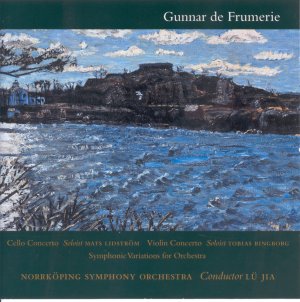It has been a while since we last heard from
Caprice. I had been wondering if they were still in the business.
This disc puts such dismal speculation to flight. The only puzzle
is the 2001 (p) and © year. It has taken a long time to surface
beyond Sweden.
Gunnar de Frumerie's music proclaims a Swedish
late-romantic. When in emphatic mode it sounds somewhat like Nielsen.
At other times he sounds like late-1940s Alwyn or early Lennox
Berkeley as in the case of Berkeley's Cello Concerto and the extraordinarily
powerful Nocturne for orchestra.
On this disc two concertos partner a set of Symphonic
Variations. As you may deduce from the timings of these works
de Frumerie was not given to prolixity.
In the lovely, haunting and dignified Cello
Concerto, de Frumerie has produced a work with, no
doubt unconscious, links to the Bax and Moeran cello concertos.
The element of mercurial fantasy is strong in the central andante
with its theme and variations. The folk graces of this work are
many and memorable - for example the repeated quiet but telling
cor anglais call at the start of the finale. The Cello Concerto
began life as the Cello Sonata No. 2 (1949) and was premiered
as a Concerto in 1985. It also exists as a Trombone Concerto,
written for Christian Lindberg (who else?), and was the composer's
last completed work in 1987.
The 1936 Violin Concerto is even more
succulently expressive of an idyllic and idealised countryside
vision. This is part Delius, part Nielsen, a touch of Vaughan
Williams' Lark Ascending and even a hint of Miklós
Rózsa. The ambling introspective andante rises to
a climactic slow statement (tr.5 5.43) which has the weighty emotionalism
of a Rubbra symphony. The finale is more agitated, even hysterical,
with moments of equilibrium restored by recollections of the first
two movements.
The Symphonic Variations take as
their subject the folk song Varvindar friska leka och viska
(Fresh spring breezes whisper and play). These variations
manage to shuffle off the contrived flavour that is the norm for
this format. The progress sounds spontaneous and always fresh.
The snarling trombone glissandi in the L'istesso tempo variant
adds some delicious humour to the proceedings. The andantino
(tr. 15) has some Nielsen-like writing for the violins, the scathing
and vigorous final variant (meno allegro) sounds rather
like Philippe Sarde's music for the Polanski film Tess.
The work comprises a statement of the theme, eleven variations
of between 42 seconds and 2 minutes 47 seconds and a valedictory
fugue.
I can, and do, unhesitatingly recommend this
disc to the legion of admirers of Moeran, Bax, Nielsen, Alwyn
and Rózsa - not that de Frumerie is any epigone of any
of these people. He is his own man but his life-enhancing outdoor
vision owes a little to each of them. Buy with confidence that
this will leave you wanting much more by this composer. We must
hope that the low key Caprice and the higher exposure Phono Suecia
will exhaustively record de Frumerie's music. More please ...
and soon.
Rob Barnett
